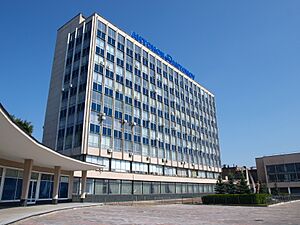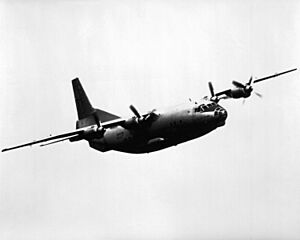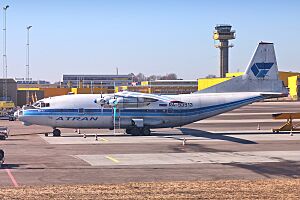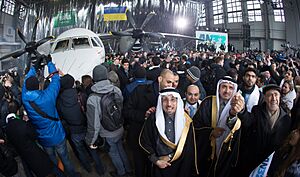Antonov facts for kids
 |
|
|
Trade name
|
Antonov Company |
|---|---|
|
Native name
|
Акціонерне товариство «Антонов»
|
|
Formerly
|
Antonov State Enterprise |
| State-owned company | |
| Industry | Aerospace and defence |
| Founded | 31 May 1946 |
| Founder | Oleg Antonov |
| Headquarters |
,
Ukraine
|
|
Key people
|
Oleksandr Donets (president of the enterprise) |
| Products |
|
| Total assets | |
| Total equity | |
| Owner | Government of Ukraine |
|
Number of employees
|
13,700 (2014) |
| Parent | Ukrainian Defense Industry |
| Divisions |
|
Antonov is a famous Ukrainian company that designs and builds airplanes. It's also known for providing services related to aircraft. Antonov is especially good at making very large airplanes and planes that can land on rough, unprepared runways.
The company has built about 22,000 aircraft in total. Many of its planes are still used today in countries that were once part of the Soviet Union and in developing nations. Antonov started in 1946 in Novosibirsk, Russia, but moved to Kyiv, Ukraine, in 1952. It is owned by the Ukrainian government.
Antonov's History
Early Years in the Soviet Union


How Antonov Started
Antonov began in 1946 as a secret design office in Novosibirsk, Russia. It was called "Research and Design Bureau No. 153." The company was led by Oleg Antonov. Their first big project was an airplane for farming, called the CX-1, which later became the famous An-2. This plane first flew on August 31, 1947. The An-2 biplane was a huge success, and many are still flying even now. In 1952, the company moved to Kyiv, Ukraine, a city with a long history of aviation.
First Big Airplanes and Growth


In 1957, Antonov introduced the An-10 and An-12 airplanes. These were medium-range planes with turboprop engines. Thousands of these aircraft were built and used for both military and civilian purposes around the world. They were important in events like the Vietnam War and the Soviet-Afghan War. They also helped with the cleanup after the Chernobyl disaster.
In 1959, Antonov started building a special base for flight testing and improvements near Hostomel, which is now Antonov Airport.
By 1965, the Antonov An-22, a very heavy military transport plane, began to be mass-produced. It was designed to help with large military and humanitarian airlifts for the Soviet Union. The An-22 was the first Soviet wide-body aircraft and is still the largest turboprop-powered plane in the world.
In 1966, after growing a lot, the company changed its name to "Kiev Mechanical Plant."
Becoming Well-Known and Oleg Antonov's Retirement

During the 1970s and early 1980s, Antonov became the main designer of military transport aircraft for the Soviet Union. Many new versions of their planes were developed and produced. After Oleg Antonov passed away in 1984, the company was officially renamed "Research and Design Bureau named after O.K. Antonov."
Big Projects and First Steps into Business

In the late 1980s, Antonov became famous worldwide for its extra-large airplanes. The An-124 "Ruslan" (built in 1982) became a key strategic airlifter for the Soviet Union. Antonov then made the "Ruslan" even bigger for the Soviet space program, creating the An-225 "Mriya" in 1985. The "Mriya" was the largest and heaviest airplane ever built.
As the Cold War ended, Antonov started to focus on commercial projects and expand internationally. In 1989, they created Antonov Airlines to handle their own aircraft maintenance and cargo transport services.
Antonov in Independent Ukraine
After Ukraine became independent in 1991, Antonov remained a state-owned company. It is considered a very important national asset.
Since then, Antonov has updated its older plane models and developed new ones to sell in new markets outside the former Soviet countries. New planes like the Antonov An-140, Antonov An-148, and Antonov An-158 regional airliners have been built and delivered to customers.
Antonov also received orders to upgrade many of its An-2 utility planes that are still flying in countries like Azerbaijan, Cuba, and Russia.
In 2014, after some political changes, Ukraine stopped its contracts with Russia. This caused Antonov's income to drop significantly. However, Ukraine has been working to find new markets, such as the Persian Gulf region, and strengthen its presence in existing ones like India.
In July 2018, Antonov made a deal with Boeing to get airplane parts that were no longer available from Russia.
Bringing Production Together
During the Soviet era, not all Antonov-designed planes were built by Antonov itself. This was because the Soviet Union wanted to spread out military production to reduce risks during a war. So, Antonov planes were often put together by other specialized companies.
In 2009, the "Aviant" airplane assembly plant in Kyiv became part of Antonov. This allowed Antonov to handle the entire manufacturing process of its planes. However, they still work with other companies, both old partners and new ones like Iran's Iran Aircraft Manufacturing Industrial Company.
In 2014, Antonov produced only two An-158 airplanes. This trend continued in 2015, with one An-148 and one An-158. Since 2016, no new aircraft have been produced or delivered to clients.
In June 2016, Ukraine's main state-owned arms company, Ukroboronprom, created the Ukrainian Aircraft Corporation. This group brought together all aircraft manufacturing companies in Ukraine, including Antonov.
On July 19, 2017, the Ukrainian government decided to simplify Antonov's structure. The larger "State Concern Antonov" business group was closed down, but the main Antonov State Company continued to operate as an enterprise.
On March 31, 2017, the first test flight of a new cargo plane, the An-132D, took place. This plane was developed as part of a contract with a customer from Saudi Arabia, but the project was later cancelled in 2019.
In February 2022, when Russia began its full-scale invasion of Ukraine, the Kyiv-Antonov-2 airfield was attacked. This airport was where Antonov did its test flights and where its planes were based. Sadly, the An-225 "Mriya", along with other planes like the An-26 and An-74, were destroyed. Other aircraft and buildings were also badly damaged.
Ukrainian authorities later found that the former director general of Antonov Company, Serhiy Bychkov, had not allowed the National Guard to prepare the site for defense in early 2022. Investigators believe this lack of preparation led to the loss of the "Mriya." In March 2023, Serhiy Bychkov was arrested in connection with these events.
An An-124 plane that was being updated at Hostomel Airport during the invasion was successfully flown out in July 2025.
What Antonov Does
Antonov is involved in many different activities:
- Designing and building airplanes.
- Transporting cargo by air through Antonov Airlines.
- Maintaining, testing, certifying, and upgrading aircraft.
- Doing research and engineering related to aerospace.
- Operating the Hostomel airport.
- Developing a special rail transport system called RADAN.
- Building LT-10A trams (trolley cars) with aluminum bodies.
- Making Kyiv-12 trolley buses, using their existing technical skills.
Main Aircraft Types
Antonov is best known for creating large military transport aircraft, including some of the biggest planes in the world. These planes were mainly for Russia and the countries that came before it.
Antonov has also made passenger planes (airliners) and many different versions of both transport and passenger planes. These versions are used for things like carrying air freight, military scouting, and command operations.
The company also developed smaller, lighter aircraft, as it originally started by making gliders.
Transport and Passenger Planes
Antonov's planes, which have the design code "An-", include a wide range of aircraft. From the tough An-2 biplane to the massive An-124 Ruslan and An-225 Mriya strategic airlifters. The An-225 was the world's heaviest aircraft, and only one was ever built.
Planes like the An-24, An-26, An-30, and An-32 are twin-turboprop aircraft with high wings. They are important for domestic and short-distance air travel, especially in regions that were once part of the Soviet Union. The An-72/An-74 series of small jetliners is gradually replacing these older planes. A larger cargo plane, the An-70, is also being certified.
The Antonov An-148 is a newer regional jet for 68–85 passengers. A longer version, the An-158, can carry 90–100 passengers.
| Aircraft | Name | First Flight | Notes |
|---|---|---|---|
| An-2 | Kukuruznik | 1947 | A multi-purpose biplane with one engine. |
| An-3 (III) | 1980 | An An-2 converted to use a turboprop engine. | |
| An-6 | Meteo | 1948 | A high-altitude weather plane based on the An-2. |
| An-8 | 1956 | A medium-sized military transport plane. | |
| An-10 | Ukraina | 1957 | A medium turboprop passenger plane. |
| An-12 | 1957 | A military turboprop transport, developed from the An-10. | |
| An-14 | Pchelka | 1958 | A light transport plane with two engines. |
| An-22 | Antei | 1965 | A very large turboprop transport plane. |
| An-24 | 1959 | A twin-turboprop passenger plane. | |
| An-26 | 1969 | A twin-turboprop transport, based on the An-24. | |
| An-28 | 1974 | A light twin-turboprop transport, developed from the An-14. | |
| An-30 | 1967 | An An-24 modified for aerial photography and mapping. | |
| An-32 | 1976 | A twin-turboprop transport for hot and high conditions, with stronger engines than the An-26. | |
| An-38 | 1994 | A light twin-turboprop transport, a stretched version of the An-28. | |
| An-70 | 1994 | A large military transport with four propfan engines, designed to replace the An-12. | |
| An-71 | 1985 | A prototype naval AWACS (Airborne Early Warning and Control) plane, developed from the An-72. | |
| An-72 | Cheburashka | 1977 | A STOL (Short Take-Off and Landing) transport, using the Coandă effect. |
| An-74 | Cheburashka | 1983 | A civilian version of the An-72. |
| An-124 | Ruslan | 1982 | A strategic airlifter; the largest aircraft ever mass-produced. |
| An-132 | 2017 | A light transport aircraft based on the An-32; project cancelled in 2019. | |
| An-140 | 1997 | A short-range turboprop passenger plane, designed to replace the An-24. | |
| An-148 | 2004 | A regional jet for 68–85 passengers. | |
| An-158 | 2010 | A stretched version of the An-148 for 99 passengers. | |
| An-178 | 2015 | A medium military transport based on the An-158. | |
| An-225 | Mriya | 1988 | A strategic airlifter derived from the An-124. It was the largest aircraft ever built, with only one in service. It was destroyed in February 2022. |
| T-2M | Maverick | 1990 | An ultralight aircraft for recreation and special forces. |
Gliders
Antonov also designed and built many gliders, which are aircraft that fly without an engine.
| Aircraft | Name | First Flight | Notes |
|---|---|---|---|
| A-1 | 1930 | A single-seat training glider. | |
| A-2 | 1942 | A two-seat training glider. | |
| A-3 | Molodv | 1955 | |
| A-7 | 1941 | A military glider. | |
| A-9 | 1948 | A single-seat glider. | |
| A-10 | 1952 | A two-seat glider. | |
| A-11 | 1958 | A record-setting glider. | |
| A-13 | 1958 | An aerobatic glider based on the A-11. | |
| A-15 | 1960 | A record-setting glider. | |
| A-40 | Krylya Tanka [Winged Tank] |
1942 | A unique flying tank. |
Images for kids




